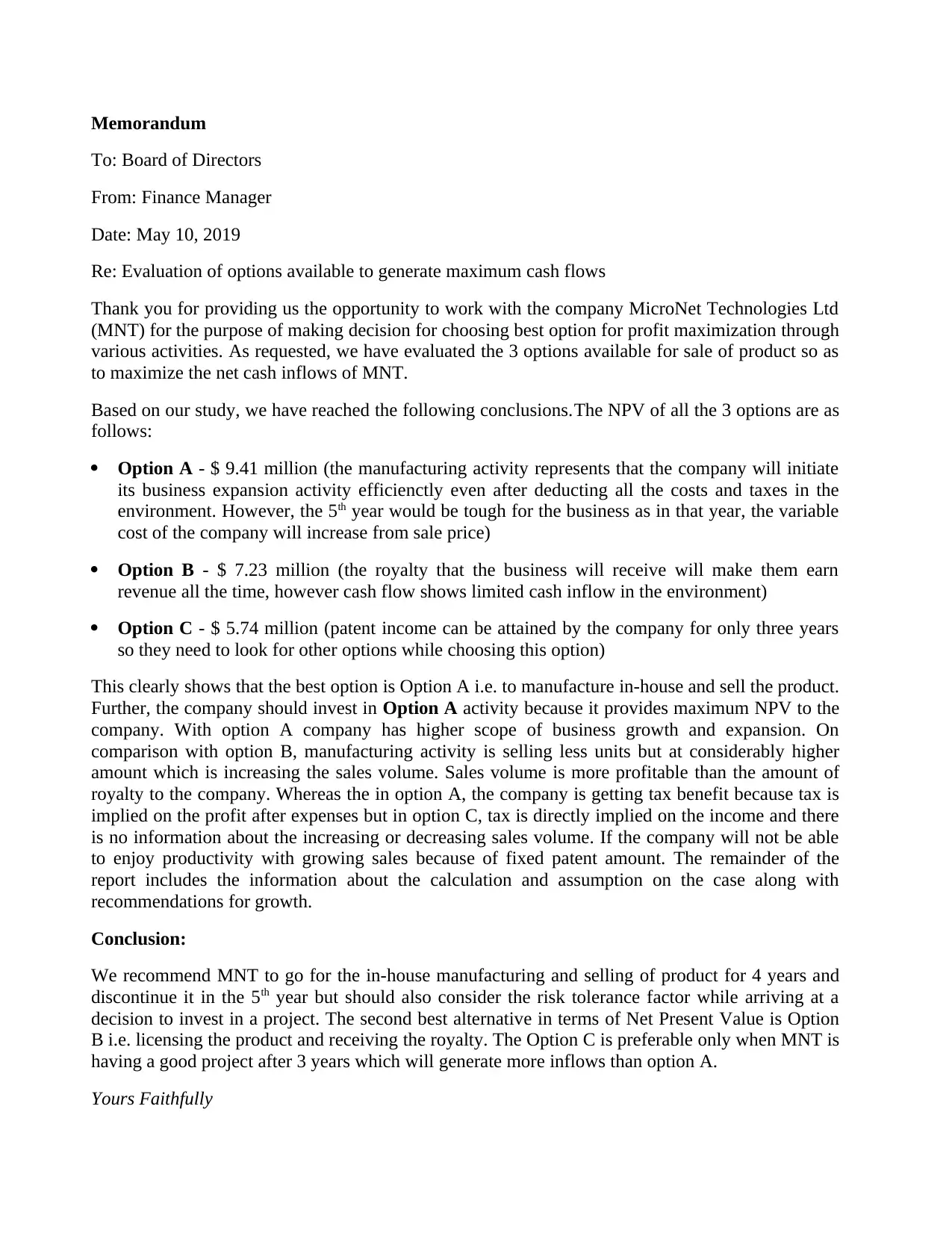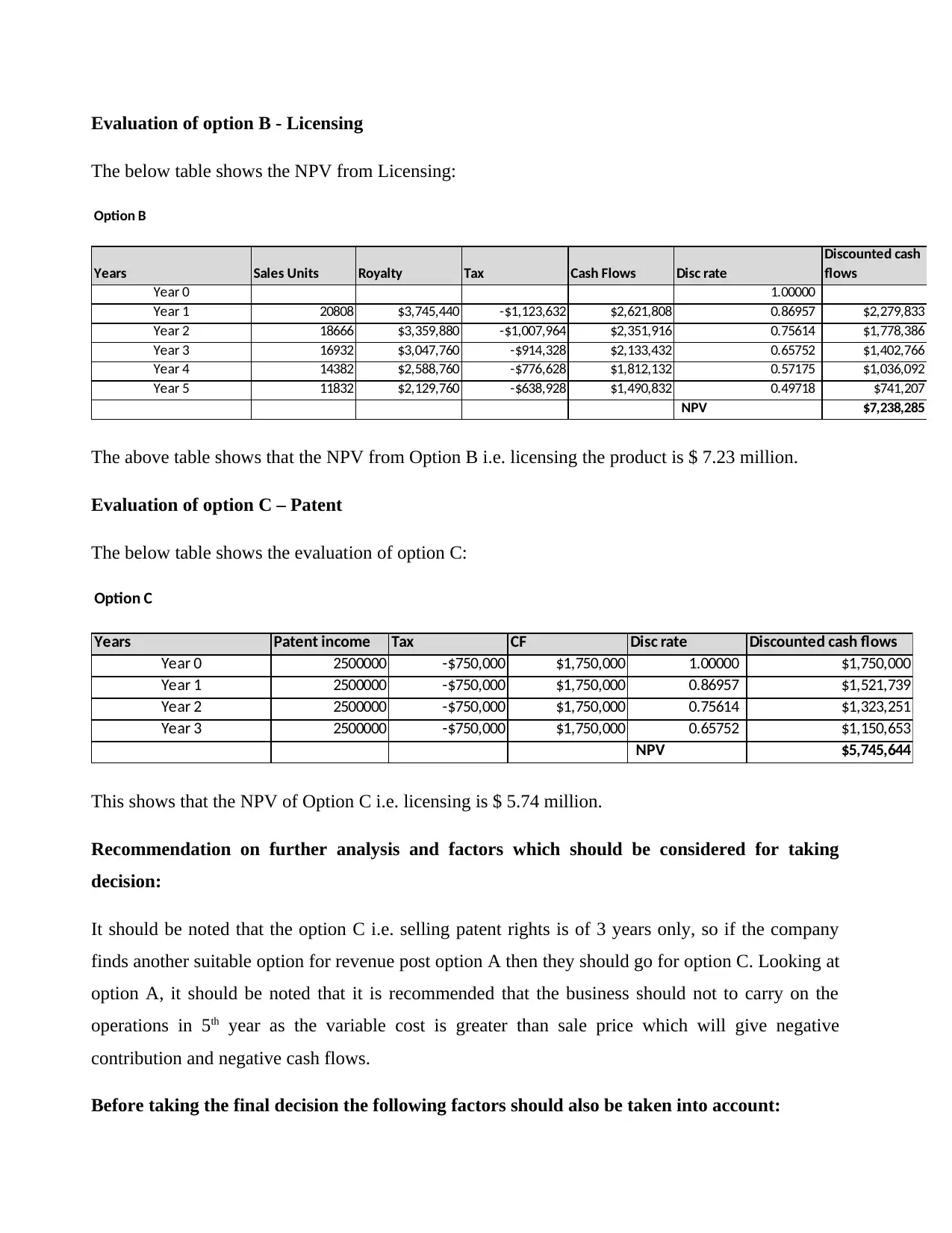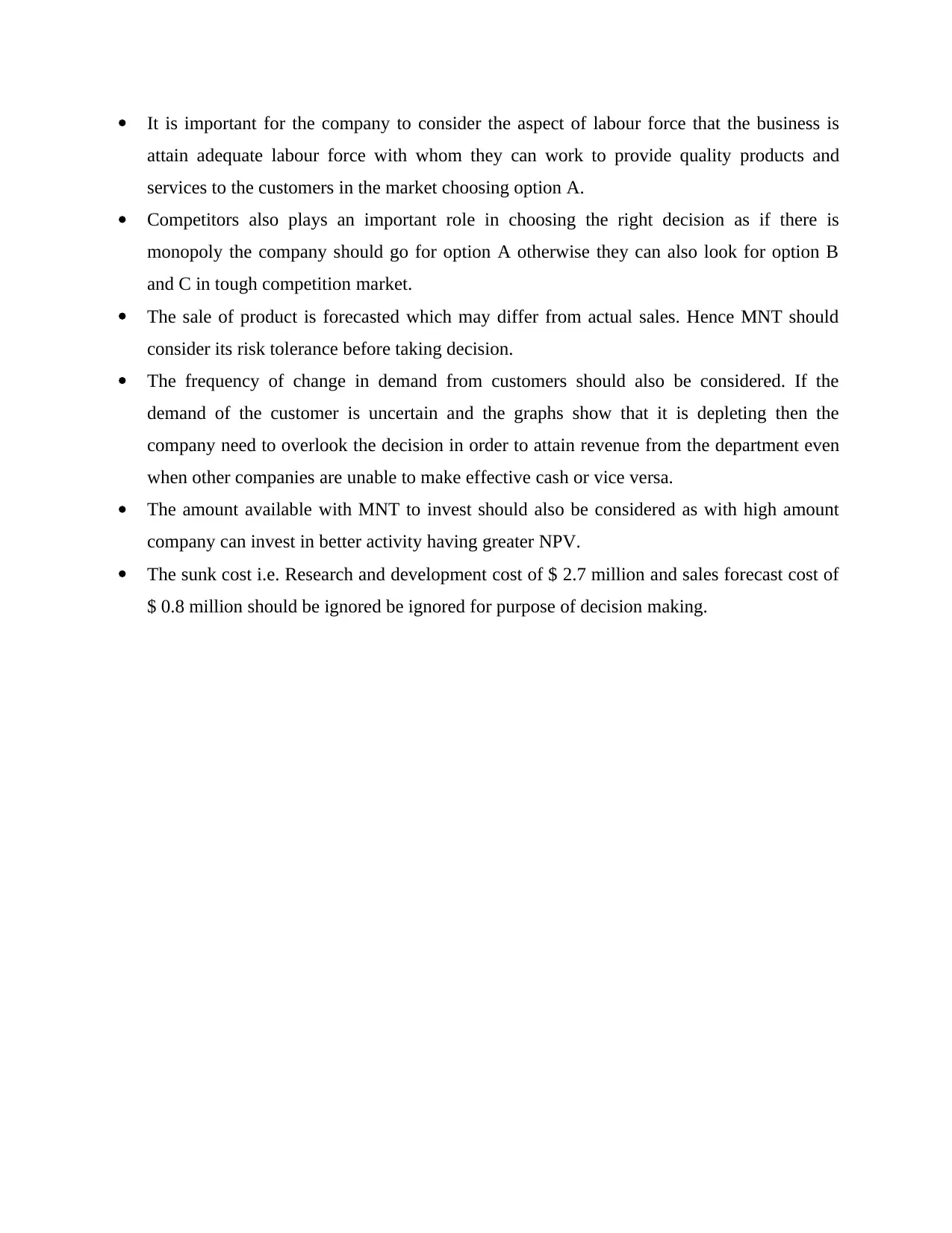ACC00152: MicroNet Tech Options Evaluation and Recommendation Report
VerifiedAdded on 2023/01/19
|4
|1466
|88
Report
AI Summary
This memorandum, prepared for the Board of Directors of MicroNet Technologies Ltd (MNT), evaluates three options for commercializing a new technology: in-house manufacturing and sales (Option A), licensing (Option B), and selling patent rights (Option C). The analysis, based on a Net Present Value (NPV) approach, considers factors such as sales, variable and fixed costs, taxes, and discount rates. Option A is identified as the most financially attractive, with an NPV of $9.41 million, followed by Option B ($7.23 million) and Option C ($5.74 million). The report recommends Option A for four years, considering its higher growth potential, but cautions against continuing into the fifth year due to increasing variable costs. It also suggests considering factors such as the labor force, market competition, risk tolerance, customer demand, available investment capital, and sunk costs before making a final decision. The report includes detailed calculations for each option, including depreciation, working capital, and tax shield calculations, to support the recommendations.

Memorandum
To: Board of Directors
From: Finance Manager
Date: May 10, 2019
Re: Evaluation of options available to generate maximum cash flows
Thank you for providing us the opportunity to work with the company MicroNet Technologies Ltd
(MNT) for the purpose of making decision for choosing best option for profit maximization through
various activities. As requested, we have evaluated the 3 options available for sale of product so as
to maximize the net cash inflows of MNT.
Based on our study, we have reached the following conclusions.The NPV of all the 3 options are as
follows:
Option A - $ 9.41 million (the manufacturing activity represents that the company will initiate
its business expansion activity efficienctly even after deducting all the costs and taxes in the
environment. However, the 5th year would be tough for the business as in that year, the variable
cost of the company will increase from sale price)
Option B - $ 7.23 million (the royalty that the business will receive will make them earn
revenue all the time, however cash flow shows limited cash inflow in the environment)
Option C - $ 5.74 million (patent income can be attained by the company for only three years
so they need to look for other options while choosing this option)
This clearly shows that the best option is Option A i.e. to manufacture in-house and sell the product.
Further, the company should invest in Option A activity because it provides maximum NPV to the
company. With option A company has higher scope of business growth and expansion. On
comparison with option B, manufacturing activity is selling less units but at considerably higher
amount which is increasing the sales volume. Sales volume is more profitable than the amount of
royalty to the company. Whereas the in option A, the company is getting tax benefit because tax is
implied on the profit after expenses but in option C, tax is directly implied on the income and there
is no information about the increasing or decreasing sales volume. If the company will not be able
to enjoy productivity with growing sales because of fixed patent amount. The remainder of the
report includes the information about the calculation and assumption on the case along with
recommendations for growth.
Conclusion:
We recommend MNT to go for the in-house manufacturing and selling of product for 4 years and
discontinue it in the 5th year but should also consider the risk tolerance factor while arriving at a
decision to invest in a project. The second best alternative in terms of Net Present Value is Option
B i.e. licensing the product and receiving the royalty. The Option C is preferable only when MNT is
having a good project after 3 years which will generate more inflows than option A.
Yours Faithfully
To: Board of Directors
From: Finance Manager
Date: May 10, 2019
Re: Evaluation of options available to generate maximum cash flows
Thank you for providing us the opportunity to work with the company MicroNet Technologies Ltd
(MNT) for the purpose of making decision for choosing best option for profit maximization through
various activities. As requested, we have evaluated the 3 options available for sale of product so as
to maximize the net cash inflows of MNT.
Based on our study, we have reached the following conclusions.The NPV of all the 3 options are as
follows:
Option A - $ 9.41 million (the manufacturing activity represents that the company will initiate
its business expansion activity efficienctly even after deducting all the costs and taxes in the
environment. However, the 5th year would be tough for the business as in that year, the variable
cost of the company will increase from sale price)
Option B - $ 7.23 million (the royalty that the business will receive will make them earn
revenue all the time, however cash flow shows limited cash inflow in the environment)
Option C - $ 5.74 million (patent income can be attained by the company for only three years
so they need to look for other options while choosing this option)
This clearly shows that the best option is Option A i.e. to manufacture in-house and sell the product.
Further, the company should invest in Option A activity because it provides maximum NPV to the
company. With option A company has higher scope of business growth and expansion. On
comparison with option B, manufacturing activity is selling less units but at considerably higher
amount which is increasing the sales volume. Sales volume is more profitable than the amount of
royalty to the company. Whereas the in option A, the company is getting tax benefit because tax is
implied on the profit after expenses but in option C, tax is directly implied on the income and there
is no information about the increasing or decreasing sales volume. If the company will not be able
to enjoy productivity with growing sales because of fixed patent amount. The remainder of the
report includes the information about the calculation and assumption on the case along with
recommendations for growth.
Conclusion:
We recommend MNT to go for the in-house manufacturing and selling of product for 4 years and
discontinue it in the 5th year but should also consider the risk tolerance factor while arriving at a
decision to invest in a project. The second best alternative in terms of Net Present Value is Option
B i.e. licensing the product and receiving the royalty. The Option C is preferable only when MNT is
having a good project after 3 years which will generate more inflows than option A.
Yours Faithfully
Paraphrase This Document
Need a fresh take? Get an instant paraphrase of this document with our AI Paraphraser

Options Evaluation:
Our analysis is done based on all the factors that would impact our cash flows i.e. Sales, Variable
cost, Fixed Costs, Opportunity costs, Tax and Discount rate.
Evaluation of option A
The below table shows the impact of in-house manufacturing and sale of products:
Option A
Years Sales Units Sales Value Variable cost Contribution Fixed Production Costs Marketing Costs Depreciation PBT Tax@30% PAT
Year 0
Year 1 20400 $714,000,000 -$554,880,000 $159,120,000 -$2,900,000 -$1,400,000 -$13,200,000 $141,620,000 -$42,486,000 $99,134,000
Year 2 18300 $549,000,000 -$497,760,000 $51,240,000 -$2,900,000 -$1,400,000 -$13,200,000 $33,740,000 -$10,122,000 $23,618,000
Year 3 16600 $498,000,000 -$451,520,000 $46,480,000 -$2,900,000 -$1,400,000 -$13,200,000 $28,980,000 -$8,694,000 $20,286,000
Year 4 14100 $423,000,000 -$383,520,000 $39,480,000 -$2,900,000 -$1,400,000 -$13,200,000 $21,980,000 -$6,594,000 $15,386,000
Year 5 11600 $290,000,000 -$315,520,000 -$25,520,000 -$2,900,000 -$1,400,000 -$13,200,000 -$43,020,000 $12,906,000 -$30,114,000
Note 1 - Calculation of depreciation
Amount
Cost $80,000,000
Scrap Value $14,000,000
Net $66,000,000
Life 5
Depreciation per year $13,200,000
Year 0 Year 1 Year 2 Year 3 Year 4 Year 5
Sales $714,000,000 $549,000,000 $498,000,000 $423,000,000 $290,000,000
Receivables $207,060,000 $159,210,000 $144,420,000 $122,670,000 $84,100,000
Total variable and fixed
prod'n costs -$557,780,000 -$500,660,000 -$454,420,000 -$386,420,000 -$318,420,000
Inventory $105,978,200 $95,125,400 $86,339,800 $73,419,800 $60,499,800
Payables -$105,978,200 -$95,125,400 -$86,339,800 -$73,419,800 -$60,499,800
NWC $207,060,000 $159,210,000 $144,420,000 $122,670,000 $84,100,000 $0
CF due to NWC -$207,060,000 $47,850,000 $14,790,000 $21,750,000 $38,570,000 $84,100,000
Note 3 - Calculation of tax shield
Amount
Cost of asset $80,000,000
Depreciation for tax purpose -$44,000,000
WDV of asset $36,000,000
Sale price of asset $14,000,000
Loss on sale $22,000,000
Tax shield $6,600,000
Note 2 - Calculation of Working Capital
The above analysis shows that the NPV is $ 9.41 Million from manufacturing activity.
Our analysis is done based on all the factors that would impact our cash flows i.e. Sales, Variable
cost, Fixed Costs, Opportunity costs, Tax and Discount rate.
Evaluation of option A
The below table shows the impact of in-house manufacturing and sale of products:
Option A
Years Sales Units Sales Value Variable cost Contribution Fixed Production Costs Marketing Costs Depreciation PBT Tax@30% PAT
Year 0
Year 1 20400 $714,000,000 -$554,880,000 $159,120,000 -$2,900,000 -$1,400,000 -$13,200,000 $141,620,000 -$42,486,000 $99,134,000
Year 2 18300 $549,000,000 -$497,760,000 $51,240,000 -$2,900,000 -$1,400,000 -$13,200,000 $33,740,000 -$10,122,000 $23,618,000
Year 3 16600 $498,000,000 -$451,520,000 $46,480,000 -$2,900,000 -$1,400,000 -$13,200,000 $28,980,000 -$8,694,000 $20,286,000
Year 4 14100 $423,000,000 -$383,520,000 $39,480,000 -$2,900,000 -$1,400,000 -$13,200,000 $21,980,000 -$6,594,000 $15,386,000
Year 5 11600 $290,000,000 -$315,520,000 -$25,520,000 -$2,900,000 -$1,400,000 -$13,200,000 -$43,020,000 $12,906,000 -$30,114,000
Note 1 - Calculation of depreciation
Amount
Cost $80,000,000
Scrap Value $14,000,000
Net $66,000,000
Life 5
Depreciation per year $13,200,000
Year 0 Year 1 Year 2 Year 3 Year 4 Year 5
Sales $714,000,000 $549,000,000 $498,000,000 $423,000,000 $290,000,000
Receivables $207,060,000 $159,210,000 $144,420,000 $122,670,000 $84,100,000
Total variable and fixed
prod'n costs -$557,780,000 -$500,660,000 -$454,420,000 -$386,420,000 -$318,420,000
Inventory $105,978,200 $95,125,400 $86,339,800 $73,419,800 $60,499,800
Payables -$105,978,200 -$95,125,400 -$86,339,800 -$73,419,800 -$60,499,800
NWC $207,060,000 $159,210,000 $144,420,000 $122,670,000 $84,100,000 $0
CF due to NWC -$207,060,000 $47,850,000 $14,790,000 $21,750,000 $38,570,000 $84,100,000
Note 3 - Calculation of tax shield
Amount
Cost of asset $80,000,000
Depreciation for tax purpose -$44,000,000
WDV of asset $36,000,000
Sale price of asset $14,000,000
Loss on sale $22,000,000
Tax shield $6,600,000
Note 2 - Calculation of Working Capital
The above analysis shows that the NPV is $ 9.41 Million from manufacturing activity.

Evaluation of option B - Licensing
The below table shows the NPV from Licensing:
Option B
Years Sales Units Royalty Tax Cash Flows Disc rate
Discounted cash
flows
Year 0 1.00000
Year 1 20808 $3,745,440 -$1,123,632 $2,621,808 0.86957 $2,279,833
Year 2 18666 $3,359,880 -$1,007,964 $2,351,916 0.75614 $1,778,386
Year 3 16932 $3,047,760 -$914,328 $2,133,432 0.65752 $1,402,766
Year 4 14382 $2,588,760 -$776,628 $1,812,132 0.57175 $1,036,092
Year 5 11832 $2,129,760 -$638,928 $1,490,832 0.49718 $741,207
NPV $7,238,285
The above table shows that the NPV from Option B i.e. licensing the product is $ 7.23 million.
Evaluation of option C – Patent
The below table shows the evaluation of option C:
Option C
Years Patent income Tax CF Disc rate Discounted cash flows
Year 0 2500000 -$750,000 $1,750,000 1.00000 $1,750,000
Year 1 2500000 -$750,000 $1,750,000 0.86957 $1,521,739
Year 2 2500000 -$750,000 $1,750,000 0.75614 $1,323,251
Year 3 2500000 -$750,000 $1,750,000 0.65752 $1,150,653
NPV $5,745,644
This shows that the NPV of Option C i.e. licensing is $ 5.74 million.
Recommendation on further analysis and factors which should be considered for taking
decision:
It should be noted that the option C i.e. selling patent rights is of 3 years only, so if the company
finds another suitable option for revenue post option A then they should go for option C. Looking at
option A, it should be noted that it is recommended that the business should not to carry on the
operations in 5th year as the variable cost is greater than sale price which will give negative
contribution and negative cash flows.
Before taking the final decision the following factors should also be taken into account:
The below table shows the NPV from Licensing:
Option B
Years Sales Units Royalty Tax Cash Flows Disc rate
Discounted cash
flows
Year 0 1.00000
Year 1 20808 $3,745,440 -$1,123,632 $2,621,808 0.86957 $2,279,833
Year 2 18666 $3,359,880 -$1,007,964 $2,351,916 0.75614 $1,778,386
Year 3 16932 $3,047,760 -$914,328 $2,133,432 0.65752 $1,402,766
Year 4 14382 $2,588,760 -$776,628 $1,812,132 0.57175 $1,036,092
Year 5 11832 $2,129,760 -$638,928 $1,490,832 0.49718 $741,207
NPV $7,238,285
The above table shows that the NPV from Option B i.e. licensing the product is $ 7.23 million.
Evaluation of option C – Patent
The below table shows the evaluation of option C:
Option C
Years Patent income Tax CF Disc rate Discounted cash flows
Year 0 2500000 -$750,000 $1,750,000 1.00000 $1,750,000
Year 1 2500000 -$750,000 $1,750,000 0.86957 $1,521,739
Year 2 2500000 -$750,000 $1,750,000 0.75614 $1,323,251
Year 3 2500000 -$750,000 $1,750,000 0.65752 $1,150,653
NPV $5,745,644
This shows that the NPV of Option C i.e. licensing is $ 5.74 million.
Recommendation on further analysis and factors which should be considered for taking
decision:
It should be noted that the option C i.e. selling patent rights is of 3 years only, so if the company
finds another suitable option for revenue post option A then they should go for option C. Looking at
option A, it should be noted that it is recommended that the business should not to carry on the
operations in 5th year as the variable cost is greater than sale price which will give negative
contribution and negative cash flows.
Before taking the final decision the following factors should also be taken into account:
⊘ This is a preview!⊘
Do you want full access?
Subscribe today to unlock all pages.

Trusted by 1+ million students worldwide

It is important for the company to consider the aspect of labour force that the business is
attain adequate labour force with whom they can work to provide quality products and
services to the customers in the market choosing option A.
Competitors also plays an important role in choosing the right decision as if there is
monopoly the company should go for option A otherwise they can also look for option B
and C in tough competition market.
The sale of product is forecasted which may differ from actual sales. Hence MNT should
consider its risk tolerance before taking decision.
The frequency of change in demand from customers should also be considered. If the
demand of the customer is uncertain and the graphs show that it is depleting then the
company need to overlook the decision in order to attain revenue from the department even
when other companies are unable to make effective cash or vice versa.
The amount available with MNT to invest should also be considered as with high amount
company can invest in better activity having greater NPV.
The sunk cost i.e. Research and development cost of $ 2.7 million and sales forecast cost of
$ 0.8 million should be ignored be ignored for purpose of decision making.
attain adequate labour force with whom they can work to provide quality products and
services to the customers in the market choosing option A.
Competitors also plays an important role in choosing the right decision as if there is
monopoly the company should go for option A otherwise they can also look for option B
and C in tough competition market.
The sale of product is forecasted which may differ from actual sales. Hence MNT should
consider its risk tolerance before taking decision.
The frequency of change in demand from customers should also be considered. If the
demand of the customer is uncertain and the graphs show that it is depleting then the
company need to overlook the decision in order to attain revenue from the department even
when other companies are unable to make effective cash or vice versa.
The amount available with MNT to invest should also be considered as with high amount
company can invest in better activity having greater NPV.
The sunk cost i.e. Research and development cost of $ 2.7 million and sales forecast cost of
$ 0.8 million should be ignored be ignored for purpose of decision making.
1 out of 4